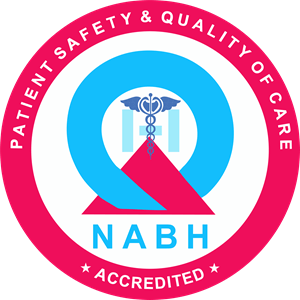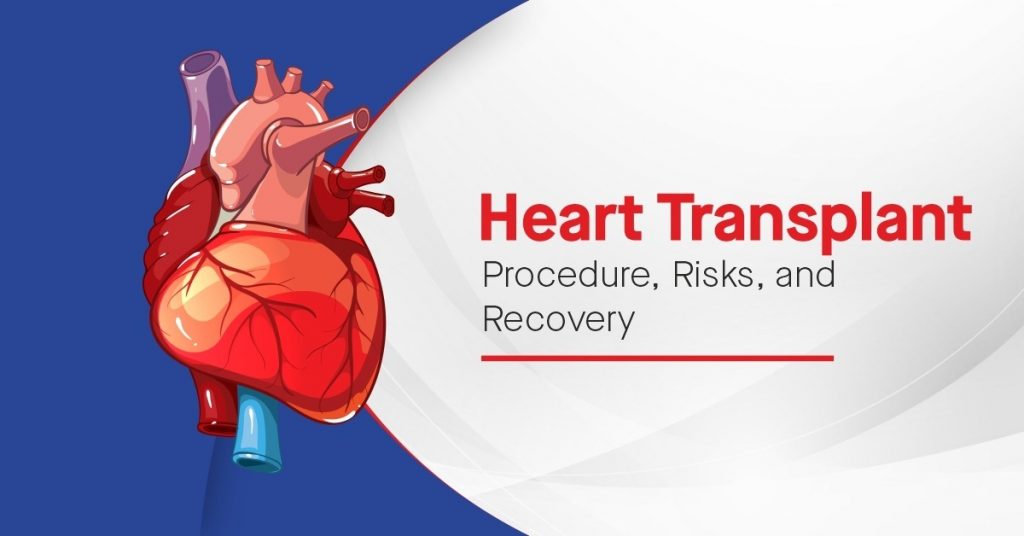What is a Heart Transplant?
The goal of a heart transplant is to replace an inoperable heart with one that has been taken from a healthy donor. The donation of organs is the result of a person’s family agreeing to donate their loved one’s organs (who has died or going to die).
The most serious cases of heart disease are treated with a heart transplant. Heart failure patients who are in the final stages of the disease can take advantage of this treatment option. We have tried medications, lifestyle changes, and less invasive procedures and none of them worked. But heart transplant is successful in saving a person’s life who had been suffering from a heart problem, by a major percentage.
Types of Heart Transplant
A heart transplant can be performed in two different ways. It will depend on your specific health needs and which one will be appropriate for you.
- Orthotopic approach: Orthotopic surgery involves replacing the recipient’s heart with a donor’s heart and is more commonly performed. As the heart transplant is being performed, the recipient receives general anesthesia and is put on a bypass machine to oxygenate the blood. The donor’s heart is prepared for fitting into the recipient’s heart and implanted after the recipient’s heart has been removed.
- Heterotopic approach: The recipient’s heart remains in place with heterotopic transplants, also known as piggyback transplants. The donor’s heart is placed on the right side of the chest. In most cases, this procedure is reserved for patients suffering from certain types of pulmonary diseases
Candidacy for Heart Transplants:
Patients who are candidates for heart transplants have experienced heart disease or heart failure for a variety of reasons, including:
- a congenital defect
- coronary artery disease
- a valve dysfunction or disease
- a weakened heart muscle, or cardiomyopathy
There are still other factors considered when determining your candidacy even if you have one of these conditions. Among them are:
- Your age. Heart transplant candidates must be younger than 65 years of age.
- Your overall health. You may not be eligible for a transplant if you have multiple organ failure, cancer, or other serious medical condition.
- Your attitude. You should commit to living a healthy life if you get a transplant. Taking care of your body requires exercise, healthy eating, and quitting smoking if you smoke.
- Blood type: It is essential to ensure compatible blood types to reduce the risk of rejection of organs.
- Body size: To guarantee compatibility, a donor and a recipient need to be of a similar size. Large men’s hearts can never fit into petite women’s, and vice versa.
Those who are determined to be ideal candidates for a heart transplant go on the waiting list until a donor heart that matches their blood type and tissue type becomes available.
Who Is Not a Good Candidate?
A heart transplant has some general contraindications, though these are determined by the center where the transplant is performed, and even the surgeon who performs the transplant. It may be a contraindication for one transplant center to consider a patient for transplantation but it may not be the case for another center.
Transplantation may be temporarily halted by some of these issues. When you have a high fever and an active infection, for example, you cannot have a transplant while you are ill. Once you are well, however, you may receive a transplant.
The following conditions do not qualify a person for a heart transplant:
- Active infection
- Inability to manage the post-transplant regimen
- Current addictive behavior includes illegal drugs, alcohol, and nicotine
- If you have a cancer history, are currently being treated for cancer, or are at risk of recurrence
- Dementia
- Irreversible pulmonary hypertension
- Severe vascular disease
- Another organ suffering from severe disease may be possible to transplant (for example, a heart-kidney transplant).
- Presence of an additional terminal disease
The procedure of Heart Transplant
Before Surgery:
Your standard pre-surgical tests will be conducted once your transplant looks imminent to ensure you are healthy enough to withstand the procedure. They include:
- Your liver and kidney function, as well as the various components of your blood, are checked with blood tests
- A chest X-ray
- Your heart’s functioning is assessed with an electrocardiogram (EKG).
- Your heart is visualized in detail through echocardiography. As the name implies, it provides information about the size and shape of your heart as well as its chambers and valves.
Surgical process:
Arriving at the hospital is the first step in the heart transplant procedure. Patients may already be in the hospital due to illness when an organ becomes available. Others may receive a phone call informing them that a match has been made.
As soon as you arrive at the hospital, you will be given a blood sample, an IV, and likely an indwelling catheter such as a PICC line for fluids, medications, and the like that will be administered during and after the surgery.
Anesthesiologists provide general anesthesia in the operating room. An incision in the middle of the chest is made while the patient is asleep, cutting through the skin and the bone beneath the skin to expose the heart. It is not uncommon for two surgeons to operate together to make the transplant process faster and easier.
The patient is placed on a heart-lung bypass machine to continue to receive oxygen from the lungs while the blood is being pumped into the body. This second part of the surgery is crucial because the heart is then stopped and removed from the body.
Afterward, the donor’s heart is sewed in place and restarted. Upon finishing the placement of chest tubes for drainage, the chest is closed by using staples, steri-strips, or sutures to close the skin and close the sternum (breastbone).
It usually takes three to four hours to perform this surgery. Patients with ventricular assist devices (VADs) will need between six and eight hours to recover.
Additionally, portable, implantable pumps are available for patients who are healthier or who plan to use them long-term.
During the waiting period for a heart transplant, VADs keep a patient’s heart pumping blood. These devices can support the left ventricle (LVAD), the right ventricle (RVAD), or both (BIVAD). Usually, the pump of the machine is located outside the body and attached to the heart via tubes inserted in the abdomen. There are also implantable, portable pumps designed for healthier patients or longer-term use.
What’s Recovery Like?
The intensive care unit will take care of you after your surgery is over. During the period when the effects of anesthesia wear off, you will be on a breathing machine for at least six to eight hours. Nursing staff and physical therapists will guide you slowly toward greater activity once you are removed from the breathing tube.
ICU stay usually lasts two to three days, although your recovery process may determine how long you stay. If you are in the ICU, you will share a room with another patient. We will make sure you are comfortable by transferring you to a private room in the Intermediate ICU.
As you are in a private room, you can have as many family members come to visit and spend the night in the room with you. In the Intermediate ICU, your caregivers will teach you how to take care of your new heart. Your family is encouraged to spend as much time as possible with you at your bedside. Your nurses and the transplant pharmacists will also teach you your new medication regimen and how you have to follow the routine.
Strengthening your stamina and strength will be the focus of physical and occupational therapy. They will advise you on how to increase your activity level safely and effectively after you leave the hospital. In addition to educating you about proper nutrition for your transplant health, your transplant dietitian will likely provide you with guidance as to what to eat. You and your family will work with your assigned social worker to address coping skills, housing, resources, and any forms that need to be filled out.
It’s normal to worry about rejection after a transplant or to worry about returning to work after a transplant, as well as feel anxious or overwhelmed during the waiting period. During this stressful time, you may find it helpful to seek the support of family and friends.
In addition to helping you with other helpful resources and coping strategies, your transplant team can:
- Support groups of the heart transplant community: You can ease your anxiety and fears by talking to others who have been through similar experiences. Online and in-person support groups are available.
- You may be able to obtain vocational rehabilitation services from your home state’s department of vocational rehabilitation if you’re returning to work.
- Establishing realistic expectations: Realize that life after transplant is likely to be different from life before transplant. It is beneficial to set realistic expectations regarding results and recovery time as well as enlist help with routine tasks to reduce stress.
- You should educate yourself about what life after a procedure is like and ask questions about issues you don’t understand.
Follow-up after the surgery Heart Transplant
A heart transplant recovery and management depend on frequent follow-up appointments. To evaluate the health of your new heart, your medical team will perform blood tests, heart biopsies through catheterization, and echocardiograms every month for the first year after the operation.
We will adjust your immunosuppressive medication if necessary. There will also be a question asking if you’ve experienced any of these possible rejection signs:
- fever
- fatigue
- shortness of breath
- weight gain due to fluid retention
- reduced urine output
Your cardiac team needs to know about any changes in your health so they can monitor your heart function if necessary. Upon one year following the transplant, you will require yearly testing rather than frequent monitoring.
Consult your cardiologist if you’re a woman and want to start a family. A woman who has had a heart transplant can safely become pregnant. A high-risk pregnancy is considered to be one in which the expectant mother has an existing heart condition or who has undergone a transplant. They can experience pregnancy-related complications and an increased risk of organ rejection.
Diet and nutrition:
To keep your heart healthy and functioning properly after a heart transplant, you may need to adjust your diet. By eating well and exercising regularly, you can lower your risk of complications such as high blood pressure, heart disease, and diabetes.
After your transplant, a nutrition specialist (dietitian) can talk with you about your nutrition and diet needs. During your consultation, your dietitian will discuss several alternatives to unhealthy foods that you can incorporate into your eating plan.
Your dietitian’s recommendations may include:
- Eating plenty of fruits and vegetables each day
- Eating whole-grain slices of bread, cereals, and other grains
- To help your body maintain a sufficient level of calcium, drink low-fat or fat-free milk or consume other low-fat or fat-free dairy products
- A lean meat diet, which includes fish and poultry
- Maintaining a low-salt diet
- You should not consume saturated and trans fat.
- Grapefruit and grapefruit juice should be avoided due to their effect on immunosuppressive medications (calcineurin inhibitors).
- Avoiding excessive alcohol
- Maintaining hydration by drinking plenty of water and other fluids every day
- Infection risks can be reduced by following the food safety guidelines
Exercise:
Exercise helps you feel stronger and boost your energy levels after heart transplantation. Besides it preventing high blood pressure and elevated cholesterol, it also helps you maintain a healthy weight, reduce stress, and reduce common post-transplant complications.
Depending on your individual needs and goals, your transplant team will prescribe a physical activity program.
It is possible to live a healthy, active lifestyle after receiving a transplant by walking, bicycling, swimming, and doing low-impact strength training. Before you begin or change your post-transplant exercise routine, be sure to speak with your transplant team.





















 Disclaimer: The information on the Web Site is provided for informational purposes only and is not meant to substitute the advice provided by our doctor or other health care professional. You should not use the information available on or through the Web Site for treating a health problem or disease or prescribing any medication. All images used on this website are for illustrative purposes only,
Disclaimer: The information on the Web Site is provided for informational purposes only and is not meant to substitute the advice provided by our doctor or other health care professional. You should not use the information available on or through the Web Site for treating a health problem or disease or prescribing any medication. All images used on this website are for illustrative purposes only,